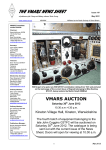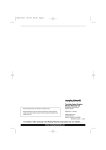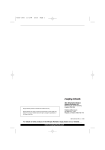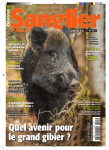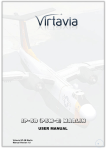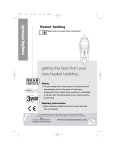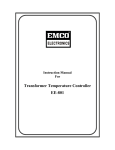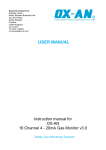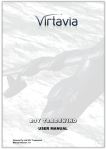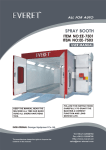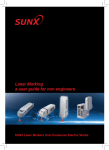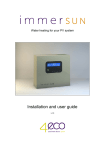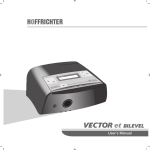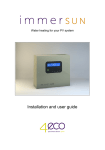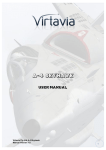Download Avro Lincoln User Manual
Transcript
AVRO LINCOLN USER MANUAL Virtavia Avro Lincoln Manual Version 3.0 0 Introduction Designed as a replacement for the Lancaster, the Lincoln was built as a long-range bomber for missions into Eastern Europe, and for use in the Pacific war against Japan. Originally dubbed Lancaster Mk 4, the extent of the re-design was such that a new type number and name was justified. Apart from Australia, the only other export customer for the Lincoln was Argentina. The first Lincoln B.1 flew in June 1944. Only about 50 aircraft had been flown by May 1945 and with the end of WWII Lincoln production contracts were cut back sharply. The first unit to take delivery in February of 1946 was 44 Squadron which had been the recipient of the Lancaster 4 years earlier. A total of 447 Lincoln B.2s were built before production ended in 1947. Between 1950 and 1955 the Lincoln was used for anti-terrorist operations in Malaya and Kenya. The Australians continued to produce Lincolns until 1953 and retired the type in mid-1961. The Virtavia Avro Lincoln is a fully 'native' FSX release, which includes visual effects such as self shadowing, bloom and bump mapping. Virtavia Avro Lincoln Manual Version 3.0 1 Installation An easy installation is provided by way of an auto-installer, the Lincoln will be installed to the default FSX folder structure. The install path can be edited in the Installer Dialogue to reflect a custom installation path such as E:Games\FSX\ for example. Extras such as this manual will be installed into FSX/Virtavia. A start menu entry will also be made, with an uninstaller should you ever wish to remove the product. Please see the ‘Package Contents’ section for more details on what is included in this package. Credits Exterior and interior models – Virtavia Textures – Virtavia Gauges – Herbert Pralle/Virtavia Animation coding – Virtavia Flight Dynamics - Mitch London Engine Sounds - Virtavia Manual - Virtavia Testing - Frank Safranek, Mitch London, Virtavia Recommended reading : WarPaint Series No.34, Hall Park Books Ltd, ISSN 1361-0369 The Avro Lancaster, Manchester & Lincoln Modellers Datafile, SAM Publications, ISBN 0-9533465-3-6 Virtavia Avro Lincoln Manual Version 3.0 2 Support Should you experience difficulties or require extra information about the Virtavia Avro Lincolnlin, please e-mail our technical support on [email protected] Copyright Information Please help us provide you with more top quality flight simulator models like this one by NOT using pirate copies. The flight simulation industry is not very profitable and we need all the help we can get. Please - help us grow by buying a legitimate copy. These files may not be copied (other than for backup purposes), transmitted or passed to third parties or altered in any way without the prior permission of the publisher. The source code for this product is closed. No modifications or reverse engineering may be carried out without prior consent from Virtavia. All rights reserved – copyright Virtavia Pty Ltd 2014 Virtavia Avro Lincoln Manual Version 3.0 3 Package Contents The Virtavia Avro Lincoln package contains five model variants and six texture sets, representing the following aircraft : B.MK.2, RF513, 617 Sqn. 'Dambusters', RAF Binbrook, 1947 B.Mk.2, RF386, 57 Sqn. Tiger Force, RAF East Kirkby, 1945 B.Mk.2, RF555, 61 Sqn., RAF Eastleigh, Kenya, 1954 Virtavia Avro Lincoln Manual Version 3.0 4 B.Mk.30, A73-36 (RAAF), 1. Sqn., Tengah, Singapore, 1955 MR.31, A75-57 (RAAF), 10. Sqn., Townsville, Queensland, 1955 'Aries II', Royal Air Force Flying College, RAF Manby 1951 Virtavia Avro Lincoln Manual Version 3.0 5 Exterior Model The exterior model has all the usual animations such as ailerons, elevators, cowl flaps (called ‘radiator shutters’), bomb bay doors and landing flaps. There are no speedbrakes fitted to the Lincoln. Exits Shift-E : Crew entry door, right side, aft Crew figures The crew figures can be toggled using Ctrl-W. Propellers The propeller blade pitch is animated through the range from fine to coarse pitch. There is also a special animation for feathering the blades in the event that an engine needs to be shut down in flight. This turns the blades edge-on into the slipstream for minimum drag. Propeller Pitch Settings Minimum Pitch (high RPM) Use Ctrl-F1 or mouse the Low/High RPM switches on the Prop Panel. Note how the blades are ‘flat’ to the airflow, this is termed the minimum, or ‘fine’ pitch. Maximum Pitch (low RPM) Use Ctrl-F4 or mouse the Low/High RPM switches on the Prop Panel. The blades are now angled to the airflow and can ‘bite’. Always have the props at this setting when starting or when at idle. Feathered Prop feathering is activated by pressing the large cylindrical buttons on the Main Panel, lower right side. This will stop the engine and simultaneously turn the blades to the minimum drag position. The blades must first be set to maximum fine pitch (ctrl-F1) for the effect to work properly. Virtavia Avro Lincoln Manual Version 3.0 6 Bomb Bay Doors The doors are toggled open or shut using the spoiler key (/). Bomb Visibility The bombs can be toggled on/off using the bombs jettison T-bar handle on the right side of the Main Panel. Note this will reset to default (bombs visible) if you swap to another variant. There is no keypress for this. Exterior Lighting Pressing the L key will turn on all lights. You may however wish to turn them on using the appropriate switches in the cockpit, as the L key also turns the on navigation, landing lights, search light and both instrument and flood lighting in the cockpit, which should ideally be switched separately. Shift-L will toggle the nav lights and the cockpit lights. Crtl-L will toggle and animate the underwing landing light. Please refer to the cockpit section of this manual for information regarding light switch location. Virtavia Avro Lincoln Manual Version 3.0 7 Alternative Viewpoints in FSX There are several different ways of looking at the aircraft and the cockpit, select these alternative views by right-clicking in an empty area and picking the 'Aircraft' menu for external views and the 'Cockpit' menu for views inside the cabin. It is possible to zoom and pan as normal in these alternative views. Cycle though the available ones by pressing the A key. External View Options It is possible to pan and zoom as normal in all external views. Right Wing View Left Wing View Virtavia Avro Lincoln Manual Version 3.0 8 Tail View Nose View Cockpit View, Left Virtavia Avro Lincoln Manual Version 3.0 9 Cockpit View, Right Bomb Bay Interior Views It is possible to pan and zoom as normal in all interior views. Virtual Cockpit View Virtavia Avro Lincoln Manual Version 3.0 10 Copilot’s Seat View Engineer’s Panel View Pilot’s Panel View Virtavia Avro Lincoln Manual Version 3.0 11 Fuel Panel View View from aft Bomb Aimer’s View Virtavia Avro Lincoln Manual Version 3.0 12 Moving Around the Cabin Shift-Enter and Shift-Backspace : moves up and down Ctrl-Shift-Enter and Ctrl-Shift-Backspace : moves side to side Ctrl-Enter and Ctrl-Backspace : moves back and forwards Virtual Cockpit Functions Main Panel,- Left Side 1) Autopilot Control Lever. 2 levers, both toggle AP on/off. 2) Sim Icons. Quick links to FSX functions for ATC, Radios, GPS, Map, Kneeboard, Autopilot and Control Column toggle. 3) P10 Compass. A standard magnetic gyro with the larger T-shaped indicator ‘needle’ for indicating the current heading of the aircraft. The tootip will show the heading in the top half of the gyro disc, the lower half allows the tooltip to show gyro drift error, which can be adjsted using the mouse in the lowest part of the disc. Virtavia Avro Lincoln Manual Version 3.0 13 4) Autopilot Pressure Indicator. Simulated. 5) Airspeed Indicator. Shows the present airspeed in knots. 6) Artificial Horizon. 7) Vertical Speed Indicator. 8) Altimeter. Standard altimeter, knob left side for Baro Setting. Use left/right mouse click, mousewheel or left click drag to adjust. 9) Gyro Compass. Simple backup heading indicator. 10) Turn and Slip Indicator. 11) Undercarriage Position Indicator. 12) Brake Pressure Indicator. Shows braking system hydraulic fluid pressure. 13) Nav Lights Switch. Toggles the standard red/green navigation lights. 14) Landing Lights Switch. Click to extend the landing light. Ctrl-L on the keyboard will have the same function. Virtavia Avro Lincoln Manual Version 3.0 14 Main Panel - Coaming 1) Radio Magnetic Indicator. A standard RMI with the larger needle for indicating the direction of the tuned NAV 1 station and the smaller needle for indicating the direction of the tuned NDB. The yellow heading bug indicates the current autopilot heading setting. The centre knob is mouseable and sets the autopilot heading value. 2) Flaps Position Indicator. Shows flaps position in steps and is mouseable. Virtavia Avro Lincoln Manual Version 3.0 15 Pilots Panel 1) Arm Rests. Click to raise and lower the arm rests. 2) NAV-GPS Switch. Toggles NAV1 and GPS to drive the autopilot. 3) Master Battery Switch. 4) Generator Off Warning Lamps. 5) Generator Switches. 6) Instrument Lighting Switch. Provides illumination to the gauge faces only. 7) Red Flood Lighting. This function is disabled due to an FSX bug which prevents general VC illumination when bump-mapped textures are used. 8) Generator Off Warning Lamps Test Switches. 9) Bomb Bay Doors Lever. 10) Autopilot Rate of Climb Adjuster Wheel. Can be operated by single mouse click or mousewheel. Virtavia Avro Lincoln Manual Version 3.0 16 Main Panel - Centre 1) Magneto Switches. Each has only two positions, on and off. The switch can not be used as a starter. Setting to ‘OFF’ will stop the engine. Use right mouse click to turn the switch to the OFF position. 2) Supercharger Warning Lamps. Superchargers are not supported by FSX, however these four lamps (one for each engine) will illuminate automatically at 11,000ft to show that the supercharger in question has automatically shifted into high gear. This is only for authenticity and has no effect on performance. 3) Supercharger Warning Lamps Test. Press to test the functionality of the warning lamps. 4) Boost Pressure Indicators. Virtavia Avro Lincoln Manual Version 3.0 17 5) Engine RPM Indicators. 6) Clock. 7) Engine Oil Pressure Indicators. 8) Intake Heating Switch. Toggles Engine and Pitot Anti-Icing. 9) Master Fuel Cocks, Engines 1 & 2. The levers operate as on/off switches which control the fuel supply to the engine. 10) Engine Throttle Levers. The levers can be moved independently with the mouse by dragging on any part of the lever. 11) Master Fuel Cocks, Engines 3 & 4. The levers operate as on/off switches which control the fuel supply to the engine. 12) Propeller Pitch Adjustment Levers. The default position is UP (fully coarse pitch). Each lever can be dragged with the mouse to any desired pitch setting. Alternatively, use the keyboard (ctrl-F4 max. coarse, ctrl-F1 max.fine). Virtavia Avro Lincoln Manual Version 3.0 18 Main Panel - Right 1) Starter Switches. Each is covered by a flap which must first be raised by clicking once. Press the button in to start the engine. 2) Primer Switches. Press the button once to prime the engine. 3) Suction Gauge. Measures combined engine suction in inHg. 4) Bombs Jettison Handle. Used to toggle the visibility of the bombs in the aircraft’s bomb bay. 5) Combined Engine Oil Temperature Indicator. Displays the temperature of the oil in the engine selected by the adjacent selector knob. 6) Engine Oil Temperature Selector. Selects which engine oil temperature is displayed on the adjacent gauge Virtavia Avro Lincoln Manual Version 3.0 19 7) Emergency Propeller Feathering Switches. Pressing the large button will set the propeller blades edge-on into the slipstream. NOTE – blades must be at fully fine pitch before they can appear fully feathered on the exterior model. Clicking a second time resets the blades to the normal position determined by the pitch levers. 8) Fire Extinguisher Warning Lamps. These illiuminate when a Fire Extinguisher is actuated. 9) Fire Extinguisher Switches. Each is covered by a flap which must first be raised by clicking once. Press the button in set off the fire extinguisher. The propeller blades should be feathered first (see (7) above). Engineers Panel 1) Heater Header Test Button. Press the button in to test the system. The adjacent ammeter will show a reading. 2) Test Ammeter. Shows a reading when any of the various test buttons are pressed. Virtavia Avro Lincoln Manual Version 3.0 20 3) Radiator Shutter Switches. Each switch opens/closes the engine radiator shutter (cowl flap) beneath each engine. The shutter is either open or closed with no intermediate positions. The radiator temperature indicator needle will also indicate the shutter status. 4) Radiator Temperature Indicators. These gauges show the temperature of the engine coolant fo reach engine. 5) Charging System Ammeters. Indicators showing the present charging level of each engine’s generator. 6) Fuel Pressure Warning Lamps. These lamps illuminate when the fuel pressure is lower than 10 psi.The lamps will be ON at engine idle as long as the Fuel Booster Pumps (Pulsometers) are off. They will also light up automatically at 15,000 ft. At this altitude the booster pumps should be used, then the lamp will extinguish. 7) Fuel Booster Pump Switches. 8) Fuel Pressure Warning Lamps Test Buttons. 9) Fuel Quantity Indicators, Wing Tanks. These numeric-style gauges provide a quick check for the Pilot and Engineer of the main tanks and wing tanks level. The same tanks are also measured by traditional gauges on the Fuel Panel (below). Virtavia Avro Lincoln Manual Version 3.0 21 Fuel Panel 1) Outer Wing Tanks. 2) Mid Wing Tanks. 3) Inner Wing Tanks. 4) Fuselage Auxiliary Tanks. These tanks are disabled in the aircraft.cfg and are optional. 5) Fuselage Auxiliary Tanks Test Buttons. Press to check functionality of the gauges. Virtavia Avro Lincoln Manual Version 3.0 22 Windows Both the sliding side windows and front direct view windows can be opened by clicking with the mouse on their respective handles/knobs. Virtavia Avro Lincoln Manual Version 3.0 23 REFERENCE INFORMATION Virtavia Avro Lincoln Procedures Location of Switches The starter switches are located on the right side of the main panel. They have safety covers which must first be opened. The magneto switches are in a row at the top centre of the main panel. The panel light switches are on the pilot’s left side console, nav and landing light switches are on the main panel, in front of the pilot, the control column can be toggled using the simicon to reveal these switches. Mouse over each switch to confirm its function. Starting Engines Use Ctrl-E (autostart) to start the aircraft, or: 1. Check Radiator Shutters (cowl flaps) are FULLY OPEN (switches on Engineer's panel). 2. Check Booster Pumps ON (switches on Engineer's panel). 3. Check Intake Heater (Pitot/Carb Heat) OFF. 4. Set throttles to IDLE. 5. Check Master Fuel Cocks Levers in ON position (location: left and right of centre console). 6. Check Magnetos ON (main panel). 7. Check Prop Pitch Levers all at fully coarse pitch (default FSX setting, ctrl-F4 if needed). 8. Set Master Battery switch ON (pilot's panel). 9. Set Navigation Lights switches to ON (main panel). 10. Prime Engine 1 using Primer Button 1 (main panel). 11. Start Engine 1 using the Engine 1 start switch. 12. Monitor engine RPM. Check that engine has not failed to start. Repeat Prime/Start for remaining engines. 13. Check temperatures & pressures (main panel). Taxi 1. 2. 3. 4. 5. Landing lights ON if required. Check Bomb Bay Doors SHUT. Check all Entry Doors and Windows SHUT. Set Parking Brake OFF. Advance throttles to begin taxying. Takeoff 1. 2. 3. 4. This section assumes maximum fuel load in all tanks. Check Autopilot OFF. Set Intake Heater Switch ON. Set flaps to takeoff (1 step on gauge). Virtavia Avro Lincoln Manual Version 3.0 24 5. Apply power smoothly to full throttle. 6. Take off occurs at approx. 125 KTS IAS. After Takeoff 1. 2. 3. 4. 5. At 140 KTS raise GEAR. At 150 KTS raise FLAPS (prepare for slight drop in climb rate). Set Radiator Shutters CLOSED. Set Fuel Booster Pumps OFF. Maintain the normal climb speed of 150 KTS, 800 ft/min using pitch or throttles. Cruising 1. Level off at desired cruise altitude. 2. Adjust speed to normal cruise speed 145 KTS (speeds up to 220 kts are possible). 3. Use autopilot to set cruise parameters. Descent 1. 2. 3. 4. 5. Begin descent 40 miles from the landing zone. Check Intake Heater Switch ON. Set Fuel Booster Pumps ON. Set Radiator Shutters OPEN. Set descent rate as desired using the autopilot. Final Approach 1. 2. 3. 4. 5. Landing lights ON, if required. Set Autopilot OFF. Set Altimeter Baro Pressure to match landing zone pressure. Enter downwind leg at 150 KTS. Set Flaps to 1 step. Landing 1. 2. 3. 4. 5. 6. Check Autopilot is OFF. Visual check there are no obstructions in landing zone. At 175 KTS, set GEAR DOWN. Set FLAPS FULLY DOWN in steps. Use throttles to maintain 110 - 120 KTS. Touchdown speed is 90 KTS. After Landing 1. Set FLAPS UP. 2. Check Radiator Shutters are OPEN. 3. Set Fuel Booster Pumps OFF. Virtavia Avro Lincoln Manual Version 3.0 25 4. Taxi to parking area. 5. Set Parking Brake ON. Shutdown 1. 2. 3. 4. 5. 6. Set Landing Lights to OFF. Set Master Fuel Cock Levers to OFF. Set Magneto Switches to OFF. Set Intaker Heater and Navigation Lights Switches to OFF. Set all cockpit and cabin lighting to OFF. Set Master Battery Switch to OFF. Virtavia Avro Lincoln Manual Version 3.0 26 Virtavia Avro Lincoln Reference Specifications Crew: 7 Engines: 4 x Packard Merlin 68A (B.Mk.2), or Rolls-Royce Merlin 85B (RAAF variants). Horsepower: 1,315 hp per engine (Merlin 68), 1,635 hp per engine (Merlin 85B). Wingspan: 120' Length: 78' 3" Tail Down Height: 17' 3” Empty Weight: 44,188 pounds Max. allowable Landing Weight : 65,000 pounds MTOW: 82,000 pounds Armament: 2 x 0.5 in. Brownings in both nose and tail turrets. 2 x 20mm Hispano cannon in dorsal turret. Up to 22,000 lbs of bombs, mines and incendiaries of various sizes and types. Flight Reference Data Maximum speed: 290 mph @ 20,000 ft (B.Mk.2) Normal. cont. cruising speed: 145 kts Max. Range: 2,800 miles (full bomb load) Service Ceiling: 32,000 feet (B.Mk.2), 27,000 ft (B.Mk.30) Max. Fuel Load: 3,650 gallons Normal climb rate: 800 feet per minute at Sea Level Stall Speeds @ 82,000 lbs: Clean - 115 kts Stall Speeds @ 75,000 lbs: Clean - 100 kts Stall Speeds @ 65,000 lbs: Clean - 95 kts, Landing - 80 kts Stall Speeds @ 56,000 lbs: Clean - 85 kts, Landing - 70 kts Virtavia Avro Lincoln Manual Version 3.0 27




























